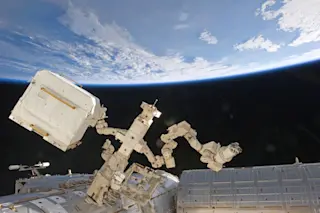Earlier this year, as astronauts busied themselves inside the International Space Station, engineers on the ground conducted their own experiment just outside the craft. Operating from a control room in Houston, they directed a nearly 60-foot-long, Canadian-built robotic arm to grab a smaller, two-armed robot called Dextre, before moving it into position in front of a washing machine-size module attached to the station.
Then, Dextre reached into the module, grabbed one of four toaster-size, custom-made, high-tech tools there, and proceeded to snip two safety wires, unscrew two filler caps on the outside of the module and pump a few liters of ethanol into a small holding tank.
The Jan. 25 exercise wasn’t especially dramatic — it made no headlines. But the maneuvers, formally known as the Robotic Refueling Mission, represent what could be a revolutionary step in space science and commerce. It’s part of the larger Notional Robotic Servicing Mission ...















